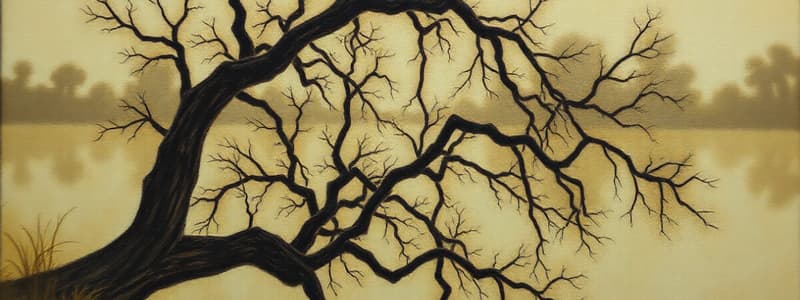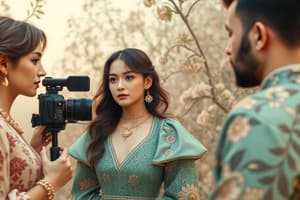Podcast
Questions and Answers
What is NOT one of the aspects of color symbolism?
What is NOT one of the aspects of color symbolism?
What is one of the key aspects in video content creation in an uncontrolled environment?
What is one of the key aspects in video content creation in an uncontrolled environment?
Which of the following is NOT a key factor in technical codes as described in the text?
Which of the following is NOT a key factor in technical codes as described in the text?
What is the purpose of an Extreme Wide Shot?
What is the purpose of an Extreme Wide Shot?
Signup and view all the answers
Which type of shot is most often used in conjunction with cowboy characters, according to the text?
Which type of shot is most often used in conjunction with cowboy characters, according to the text?
Signup and view all the answers
A shot that emphasizes the subject's actions is a...?
A shot that emphasizes the subject's actions is a...?
Signup and view all the answers
Which of the following is NOT a type of camera angle mentioned in the content?
Which of the following is NOT a type of camera angle mentioned in the content?
Signup and view all the answers
What are the three main categories of codes used in media products, according to the content?
What are the three main categories of codes used in media products, according to the content?
Signup and view all the answers
Which camera shot is best suited for capturing a character's emotions?
Which camera shot is best suited for capturing a character's emotions?
Signup and view all the answers
Which of the following is NOT an example of a written code, according to the content?
Which of the following is NOT an example of a written code, according to the content?
Signup and view all the answers
What is the first step in creating a quality video?
What is the first step in creating a quality video?
Signup and view all the answers
Which of these slogans is NOT mentioned in the content?
Which of these slogans is NOT mentioned in the content?
Signup and view all the answers
How can written codes be used in media?
How can written codes be used in media?
Signup and view all the answers
What does "mise en scene" refer to in the context of film?
What does "mise en scene" refer to in the context of film?
Signup and view all the answers
What is the primary function of symbolic codes in media?
What is the primary function of symbolic codes in media?
Signup and view all the answers
Which of the following elements is NOT considered part of "mise en scene"?
Which of the following elements is NOT considered part of "mise en scene"?
Signup and view all the answers
Which of these settings would typically convey a sense of poverty and unsanitary living conditions?
Which of these settings would typically convey a sense of poverty and unsanitary living conditions?
Signup and view all the answers
What is the primary purpose of "staging" in film?
What is the primary purpose of "staging" in film?
Signup and view all the answers
How do "technical codes" work in media?
How do "technical codes" work in media?
Signup and view all the answers
Which of the following is NOT a primary element of acting?
Which of the following is NOT a primary element of acting?
Signup and view all the answers
How can a character's actions be used to convey meaning?
How can a character's actions be used to convey meaning?
Signup and view all the answers
What is the main purpose of a close-up shot?
What is the main purpose of a close-up shot?
Signup and view all the answers
Which type of shot is designed to make the subject appear powerful or dominating?
Which type of shot is designed to make the subject appear powerful or dominating?
Signup and view all the answers
What is the purpose of an over-the-shoulder (OTS) angle?
What is the purpose of an over-the-shoulder (OTS) angle?
Signup and view all the answers
What does a Dutch angle shot typically convey?
What does a Dutch angle shot typically convey?
Signup and view all the answers
Which of these camera angles is considered neutral?
Which of these camera angles is considered neutral?
Signup and view all the answers
In camera angles, what is a 'Bird's Eye View' specifically known as?
In camera angles, what is a 'Bird's Eye View' specifically known as?
Signup and view all the answers
Which shot is commonly utilized to showcase a character's thoughts or perspective?
Which shot is commonly utilized to showcase a character's thoughts or perspective?
Signup and view all the answers
A shot focusing exclusively on the character's face or a single aspect of it, like the eyes, is called what?
A shot focusing exclusively on the character's face or a single aspect of it, like the eyes, is called what?
Signup and view all the answers
Study Notes
Traffic and Road Signs in the Philippines
- Traffic and road signs in the Philippines are categorized into Warning, Informative, and Regulatory signs.
- The presentation includes examples of each category, displaying various signs with labels.
Media Codes and Conventions
- Media codes are systems of signs that communicate meaning.
- These signs have shared meaning among communicators, for example, the word "toxic" in a hospital setting has a clear understanding.
- Codes exist outside media; their interpretation is similar in real-life.
Types of Media Codes
- Three primary types of codes are identified: symbolic, technical, and written.
Symbolic Codes
- Symbolic codes represent the underlying meaning of a scene.
- A character's actions, for example, can reveal their emotions.
- This type of code functions outside of the media product itself, mirroring audience interpretations.
Setting
- Setting refers to the time and place of a narrative.
- An example given is the movie Jaws, whose setting is commonly perceived as the ocean.
Setting Examples
- Forests can represent danger, mystery, fantasy and battlegrounds in movies.
- Slums might evoke poverty, action, and unsanitary conditions.
- Beaches might be associated with survival, leisure, catastrophe, and loneliness.
Mise en Scène
- Mise en scène is a French term that encompasses everything within a frame.
- Set design, costume, props, and staging are essential aspects of mise en scène.
Acting
- Actors portray characters through facial expressions, body language, vocal qualities, movement and body contact.
- Examples used include eye contact and specific reactions in scenes.
Color Codes
- Colors hold strong cultural connotations in media.
- Different aspects like dominant colour, contrasting, and symbolism can significantly affect the audience's perception.
Color Examples
-
Green evokes thoughts of nature, healing, perseverance, fertility.
-
Pink often symbolises femininity, innocence, playfulness, and romance.
-
Red is associated with intensity, action, anger, passion, power, and danger.
-
Yellow evokes happiness, wisdom, insecurity, and cowardice.
-
Blue often represents calm, remoteness, confidence, coldness.
-
Orange is a mix of red and yellow conveying sociability, enthusiasm, youthfulness, vibrancy, and warmth.
-
Violet represents royalty, fantasy, mystery, and eroticism.
-
Brown suggests qualities like earthiness, comfort, homeliness, endurance, and authenticity.
-
Black represents ideas like death, evil, sophistication, mystery, wealth, and danger.
-
White signifies purity, cleanliness, simplicity, peace, death, and goodness.
Camera Angles and Shots
-
Technical codes encompass camera angles and shots as key components of storytelling.
-
Extreme wide shots emphasize the setting and might isolate characters, Wide shots encompass the subject and its setting.
-
Medium full shots depict the subject from the thighs up, Medium shots feature characters from the waist up.
-
Medium close-up shots emphasize character emotions.
-
Close up shots are focused on a character's face or part of the face. Extreme close up shots isolate select features.
Technical codes in Media
- Technical codes are methods through which camera equipment, sound, camera angles, types of shots, lighting, and camera techniques are used.
Point Of View (POV)
- POV shots depict the perspective of a character, letting the audience see the world through their eyes.
Camera Angles
- Eye level angles are positioned at eye level. High angles look down on the subject. Low angles look up at the subject. OTS is from one character's perspective. Dutch angles are tilted to cause disorientation. Overhead shots are from directly above the subject.
Studying That Suits You
Use AI to generate personalized quizzes and flashcards to suit your learning preferences.
Related Documents
Description
Test your knowledge of media codes and video production with this engaging quiz. Explore key concepts such as color symbolism, camera angles, and techniques crucial for creating effective video content. Perfect for students learning about media studies and film production.




